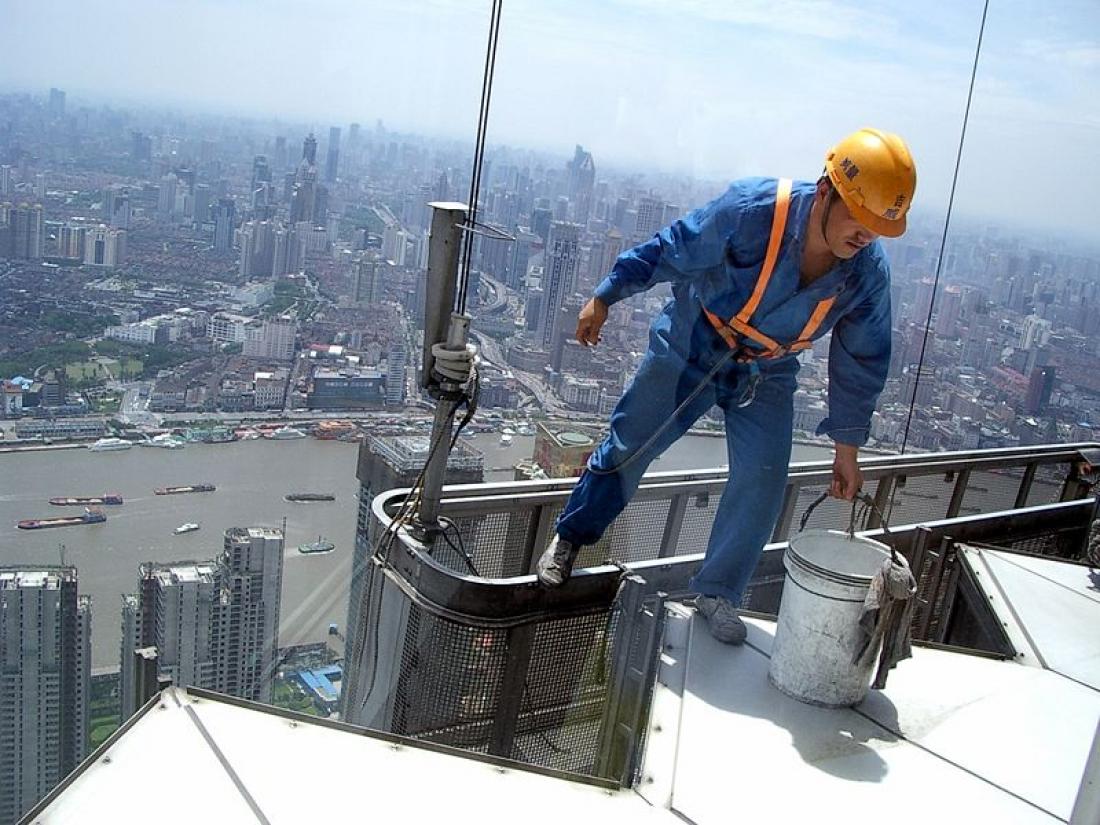A maintenance worker on a high-rise building.
Sustainable buildings ensure buildings and services are in good condition for living, working, and other daily activities. The trend in construction industry has evolved to emphasize more on building maintenance from designing and constructing new buildings, to ensure the sustainability of buildings. Building maintenance is a combination of actions performed to retain an item in, or restore it to, an acceptable condition. In fact, the evolution is due to the scarcity of land for new construction as well as environmental concern in reducing carbon footprint.
However, building maintenance is neglected as a result of extensive cost required for maintenance activities. The sustainability of buildings requires maintenance over their life cycle, which is currently not addressed. Lack of awareness towards importance of building maintenance among the building owners and occupants occurs and leads to the poorly maintained buildings. Additionally, the building owners and occupants are not aware that the building maintenance plays a vital role in providing building functionality, safety, health, and comfort to them.
In most of the buildings, regardless of commercial or residential buildings, the building owners outsource the maintenance-related activities to third party maintenance management team or managing agent in order to fulfil the maintenance needs. Nevertheless, they rarely get involved in the maintenance management. It is indeed vitally important that the building stakeholders have close communication about the maintenance-related issues. This requires their willingness to commit and contribute to maintenance management. The key stakeholders include:
(a) Maintenance management team
(b) Building owners/clients
(c) Building occupants/users
(d) Maintenance service providers
The maintenance management team plays the main role in maintenance planning and execution. The team must be able to handle the entire management complexity in building maintenance that includes planning, purchasing, personnel, quality control, inventories, technical problems and budgets. Thus, an eligible management team should be a group of personnel who have adequate knowledge, skill and experience in both administrative and technical perspectives in building maintenance practice. On behalf of the clients, their duties are as follows but not limited to:
(a) To properly maintain and management the building properties and keep it in a state of good and
serviceable repair.
(b) To collect and maintain the maintenance charges from building owners.
(c) To spend the budget for carrying out the maintenance and management tasks upon authorization of
the clients.
(d) To outsource and monitor the services those require expertise to undertake the maintenance tasks.
The building owners/clients are the decision makers for maintenance management. They should clearly brief the maintenance management team about their expectations of the maintenance management services. Their involvement in communications helps to set agreed-upon performance goals, allocate and prioritize sufficient resources or budgets, inform the management of policy and direction changes to meet these goals, and report the performance of meeting these goals. The input of the building owners/clients would create better understanding between the stakeholders and help to avoid major disruptions in the maintenance activities.
Building occupants/users are the people who most utilize building properties in their daily activities. Normally, building occupants/users can provide feedback and opinions to the maintenance management team about the performance of building and its services. Unfortunately, majority of the building occupants/users do not bother about the building and services performance as long as their daily activities are not affected. In fact, they have the responsibility to report any shortcomings to the maintenance management team for rectification.
Furthermore, the involvement of service providers in maintenance management is unavoidable as it provides maintenance expertise that is often unavailable from the in-house maintenance staff such as maintenance of lift and firefighting systems. Commonly, the service providers will carry out routine maintenance and inspection to extend the service lifetimes. They will not station in the buildings all the time. Thus, in-house maintenance staff should have some basic skill in handling the emergency event of the services. In this occasion, the service providers shall assist them by providing training or emergency maintenance procedures. The collaboration between the management team and service providers is critical.
The ideal maintenance management that has been discussed requires involvement of the key stakeholders. In reality however, many of the stakeholders refuse to contribute themselves in the maintenance management and “keep their hands clean”. They are not aware that the poor maintenance outcomes will affect them in the end. Therefore, it is essential to create awareness to the public about the involvement of the building stakeholders in maintenance management.
The recent research done by Dr. Au-Yong has demonstrated that there is significant relationship between involvement of building stakeholders and maintenance performance. It was found that the involvement in maintenance management is lacking. Therefore, the government and relevant parties should work together in promoting the importance of building maintenance management to the public.
Dr. Cheong Peng Au-Yong
Centre for Building, Construction and Tropical Architecture (BUCTA),
Department of Building Surveying, Faculty of Built Environment,
University of Malaya, 50603 Kuala Lumpur, Malaysia.
Email: [email protected]



